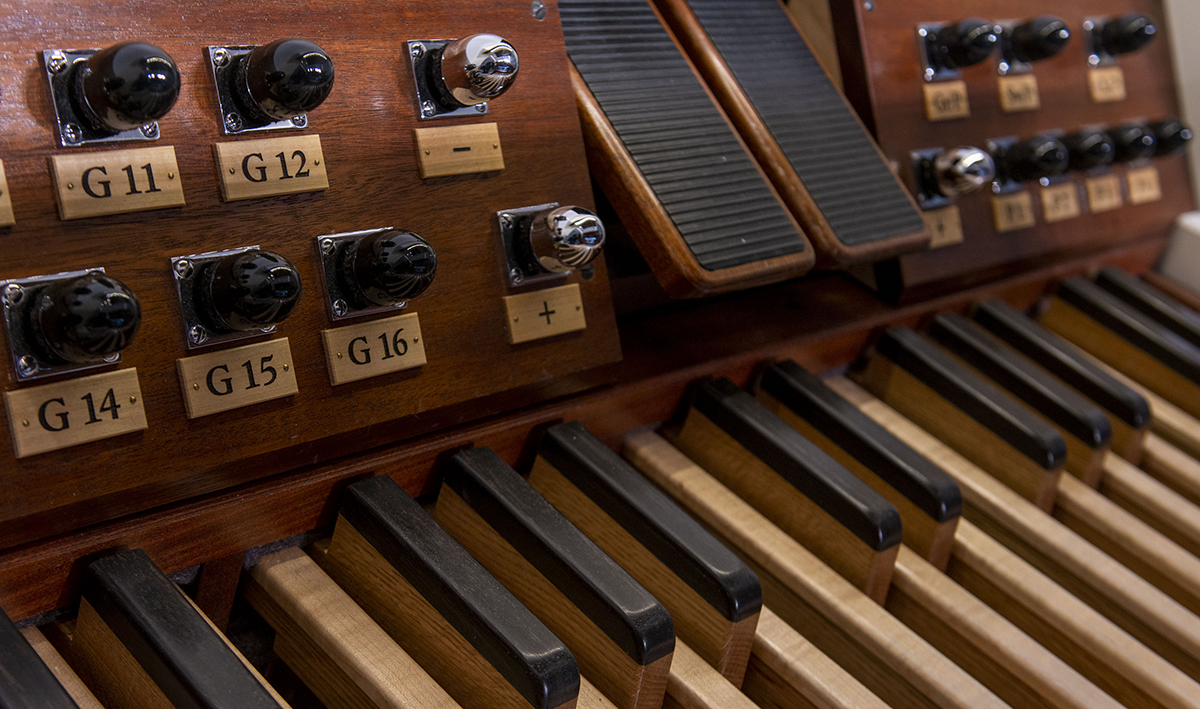
Organist Elisa Bickers Knows Her Instrument
The musician played a key role in selecting the $2 million pipe organ for a Kansas church.
The Opus 22 pipe organ at Village Presbyterian Church in Prairie Village, Kansas, has an imposing Georgian facade constructed of Tennessee tulip poplar, painted white and embellished with gilded sunflowers, cottonwood leaves and sheaves of wheat.
When Elisa Williams Bickers ’04 (MM ’06), principal organist and associate director of music ministry, sits down to play the organ for the 4,900-member congregation, her fingers trigger keys and her feet push pedals connected to long rods. The rods, called trackers, open the pallets and allow wind to be pumped into 3,600 hand-poured metal pipes weighing 17 tons.
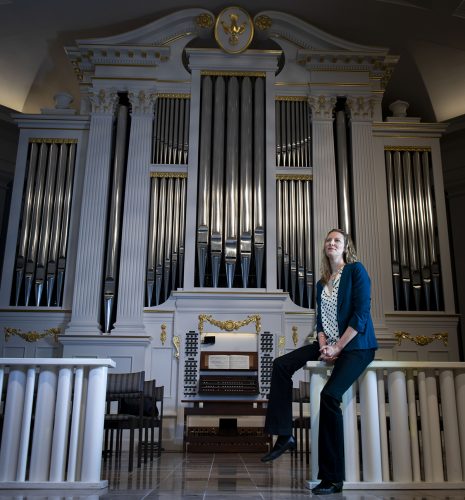
Elisa Bickers, principal organist and associate director of music ministry at Village Presbyterian Church in Kansas sits near the church’s organ. Photo by Shane Keyser
This mechanical action is the same technology used in 18th-century Dutch organs, which were designed to uplift congregational singing with a rich and sustained palette of timbres ranging from light and melodic to deeply meditative.
Seasonal weather and the forces of gravity periodically will compel Bickers to tune a pipe or oil the blowers. When the summer air is thick with humidity, a door that seems to be etched into the side of the pipe organ tends to stick. On this day, Bickers calls on a maintenance worker to give it a stronger nudge than she can muster, and then we step inside the instrument.
“I’m at one with making music when I also know how the music is being made. It’s just the way my mind works,” Bickers said.
Used to perform sacred, classical and popular music, the pipe organ predates Christianity. The instrument’s popularity has ranged from the Toccata and Fugue in D minor days of 18th-century composer Johann Sebastian Bach to the silent-film era. But in an electronic world, there has been a decline in the number of new instruments and in students to play them.
Most of what produces the Opus 22’s mighty sound is hidden from view. The wooden encasement contains a thicket of pipes arranged in ranks of size and tone. The pipes are on many levels, requiring a ladder to reach all of them.
Bickers embraced not just learning how to play the organ, but also understanding its inner workings, said H. Joseph Butler, professor of music and university organist at TCU. As his student, Butler recalled, she “was pretty fearless and not afraid to plunge in.”
“I actually worked at [organ builders] Ross King Co. in Fort Worth while I was going to TCU, and it was the smartest thing I ever did,” Bickers said. “Most organists don’t have a clue, really, what happens inside their instrument.
“If you’re playing the clarinet and something goes wrong, you can hold it in your hand and take it apart and look inside and say, ‘Oh, I see what needs to be replaced.’ But with organs, you are usually so far removed from the inner workings.”
She began playing piano when she was 8. At 12, she took up the organ and clarinet. In high school, she added oboe and English horn, and in college, the harpsichord.
But initially Bickers planned on a career in science.
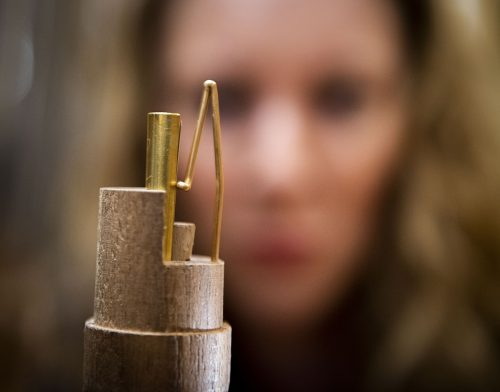
Elisa Bickers shows off one of many reeds that can be tuned in the Opus 22. Photo by Shane Keyser
She had spent summers working with birds of prey at a nature conservation center near her hometown of Clinton, Maryland. After a failed piano audition, she decided to attend TCU as a chemistry major but soon realized she was spending more time in music ensembles than in science labs.
Bickers worked up the courage to knock on Butler’s door. The professor heard enough raw talent in her playing to encourage her to study the organ. Butler advised Bickers for her bachelor’s degree in music and master’s degree in organ performance, and they have remained in touch throughout her professional career.
“I think her playing has matured wonderfully,” Butler said. “And an instrument of that caliber allows her to interact with people from all over the country and internationally.”
Bickers met her husband at TCU. Robert Bickers ’00 (MA ’07), who studied history, teaches at Shawnee Mission East High School, which is about a mile from the church in suburban Kansas City, Missouri. The couple have a 7-year-old daughter, Isabel.
Bickers received her doctorate in church music from the University of Kansas in 2010 and auditioned for her current job at Village Presbyterian as the congregation was trying to figure out whether to fix its 1980s electro-pneumatic organ, rebuild it or commission a new instrument.
For six years, Bickers met every other week with a committee of musicians and church members. After much study and deliberation and many cross-country tours to listen to other organ styles, they decided to commission a mechanical organ, an instrument they believe will last for generations and speak to future congregations.
The church contracted with Richards, Fowkes & Co., based near Chattanooga, Tennessee, to build the Opus 22. It took four years to complete the $2 million instrument.

A dove adorns the top of the Opus 22. The Village Presbyterian Church has one of the largest Presbyterian congregations in the U.S. Upon arriving at the church, one of Elisa Bicker’s first assignments was to help research and select the church’s new $2 million organ. Photo by Shane Keyser
“For it to take four years to build this is actually not so ridiculous,” Bickers said. “Everything has to be so precise. Everything is about millimeters of movement.”
Purchasing of the organ also prompted the church to renovate its sanctuary to provide better acoustics and make other improvements.
Installation of the Opus 22 (so named because it was the 22nd organ the company had built) began in September 2016. Final work on the instrument was completed in August 2017.
The organ installers lived with congregation members, and Bickers made deep friendships with team members. “It takes a village to put a pipe organ in,” she said with a laugh. That village also included Jan Kraybill, a renowned organist who is conservator of the spectacular pipe organ in Helzberg Hall at the Kauffman Center for the Performing Arts in Kansas City, Missouri.
“We are so blessed to have Elisa in the Kansas City musician community,” said Kraybill, who served as a pipe organ committee member and project consultant. “When she first came to Kansas City, people who cared about me thought she might be after my job. I wasn’t worried, but I think we often set people up as rivals.”
Instead, Bickers and Kraybill became friends. They designed a “duel” for a concert, in which they good-naturedly pushed each other off the bench while playing a duet.
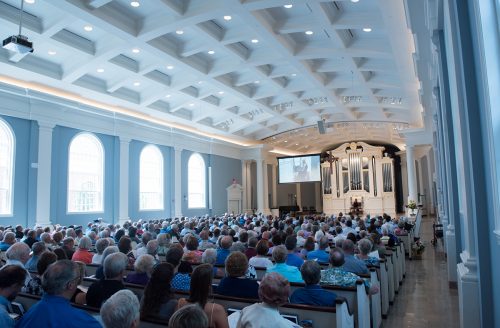
Elisa Bickers plays the Opus 22 at Village Presbyterian Church’s three Sunday services each week. The church renovated its sanctuary to provide better acoustics for its new organ. Courtesy of Elisa Bickers
Those who selected the Opus 22 considered a variety of factors. Strong preferences for music and styles of instruments exist in the pipe organ community. Committee members also considered how the organ would contribute to the worship experience and wrestled with practical concerns about the instrument’s place in the church. But Kraybill said Bickers has a passion for people and proved expert in negotiating opinions, eventually bringing everyone to a consensus.
“There is so much to pipe organ building, and to acoustics, and to welcoming in a church, with how it looks and how it sounds. It’s complicated and beautiful,” Bickers said. Like childbirth, she jokes, the labor pains were worth the gains.
“People from around the world have heard this organ, and they are flipping out,” said Bickers, who helped host the 2018 American Guild of Organists National Convention in Kansas City. “Most importantly, the people at this church seem to be in love with it.”
Bickers’ own musical accomplishments could easily be dwarfed by the immensity of her stewardship duties, but she continues to seamlessly blend virtuosity and technicality. In 2016, she earned a fellowship certification, one of the national guild’s top honors. She served as the chair for new music for the 2018 convention, which commissioned 13 compositions for the pipe organ.
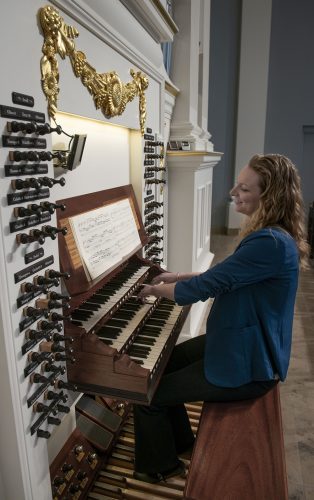
Getting in a little practice time, Elisa Bickers, principal organist and associate director of music ministry at Village Presbyterian Church, plays Felix Mendelssohn’s Fourth Sonata for Organ on the Opus 22. Photo by Shane Keyser
As an organist and harpsichordist, she tours in the U.S., Europe and Asia. She has also performed a variety of musical styles with the Bach Aria Soloists, the Te Deum Chamber Choir, the Spire Ensemble and the Grammy Award-winning Kansas City Chorale.
Bickers is proud of the legacy she has helped build and grateful for the opportunity to work as a full-time organist, but the greatest reward of her job lies in the opportunity to build a sense of community.
“To be honest, the most important fit is not what comes out of your fingers but what comes out of your mouth. When you’re coming in to work for a church, it’s not just a gig. For me, it’s a calling,” she said. “The conversation about what this church was about, and what I was about, as people is where we started. And that’s where you get good fits or bad fits in this field. It’s not so much about the notes. It’s about the relationships.”
Will Breytspraak grew up in Village Presbyterian Church and now serves as director of music, working with Bickers to minister at three Sunday services. “She really sees the organ as much more than an instrument,” Breytspraak said. “She really sees it feeding the life of the community. It’s elevated everything that goes on here.”
Making hymns come alive — to provide meter and inflection for the words — requires the right touch. “Really great hymn singing is inspirational,” Breytspraak said, “and I don’t think there would be a decline [in the art form] if there were more Elisas.”

Your comments are welcome
Comments
Related reading:
Alumni
Songs of a Visionary
Deborah Simpkin King creates transformative concert experiences.
Alumni
A Mood in Jazz
On stage or in class, Joey Carter fills the room with melodies and rhythm.
Alumni, Features
Dr. J Mack Slaughter Focuses on Healing the Spirit
The emergency room physician started Music Meets Medicine to give children with long-term illnesses a creative escape.